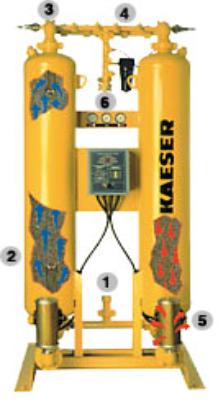- Phone: 800-492-1252
- Fax: 440-368-3569
- E-mail: info@spartanwatertreatment.com
Spartan supplies complete ozone water treatment systems including ozone generators with air driers among other options. Air drying systems for ozone generators have evolved to become more reliable, more compact and lower in cost. These systems rely on high pressure air drying technology which employ heatless pressure swing adsoprtion (PSA) systems.
In the past it was more common to see low pressure systems (about 20 psi). These unit relied on a combination of equipment including heat exchangers, refrigerant dryers and heat regenerated desiccant dryers. As a result of the amount of equipment there were numerous moving parts and potential for system failure.
PSA systems require higher pressure (about 10 psi) but rely on a single moving part. The system is composed of two columns filled with a material that can reversibly absorbs water. Air is fed through one column while the other column is regenerated. The columns are switched every few minutes to maintain a continuous supply of dry air to the ozone generator. The only moving part is the solenoid valve used to switch the flow from one column to the other. The absorbing material is long lived and relatively inexpensive. Air can be dried to a dew point of -100 degrees F (see our discussion on Feed Gas Monitoring Systems ).
The system requires an air compressor. Rotary screw compressors have been used successfully for high pressure dried air systems. Ozone generators are sensitive to hydrocarbons in compressed air. Therefore, one needs to insure low levels of oil in the compressed air. While oiless compressors are available, they are substantially more expensive than oil lubricated systems. Filtration packages offered by the compressor suppliers can lower oil levels in the compressed air to less than 0.003 ppm. The compressor should be supplied with an after cooler to insure that the air fed to the drier is less than 95 degrees F. A layout of a PSA air drying system is shown below.

Wet compressed air must first be filtered to remove particles and oil aerosols before it can be directed to the dryer inlet port where this air, via a multi- directional valve, will be directed up through a bed of activated alumina desiccant where its dew point is significantly reduced (typically to -40°F) by the time it exits the on-line (drying) tower.
A small portion of air is separated from the dry air stream by a proportioning valve and orifice and is directed to the off-line tower. The remaining dry air stream exits the dryer via another multi-directional valve. This dry air stream must be filtered for particulates before being directed to the end use.
The portion of dry air, called “purge” air, directed to the off-line tower is reduced to near atmospheric pressure before entering the tower and passing downward through the “wet” desiccant bed. The purge air, which becomes extremely dry by the reduction in pressure, readily drives adsorbed moisture off of the desiccant preparing it for another adsorption cycle. The moisture-laden purge air exhausts to atmosphere during the regeneration process.
When regeneration is complete the off-line tower is gradually returned to line pressure and the multi-directional valves now bring the just regenerated desiccant tower on-line, routing wet compressed air up through its desiccant bed and directing dry purge air down through the desiccant bed of the now off-line tower to accomplish regeneration. This process of adsorption and desorption can be repeated more than hundred thousand times before the desiccant must be replaced.